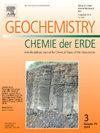Biotite geochemical fingerprints deciphering magma evolution and compositional diversity of the concentric Zhongchuan Batholith, West Qinling, China
IF 2.9
3区 地球科学
Q2 GEOCHEMISTRY & GEOPHYSICS
引用次数: 0
Abstract
Compositional diversity is a common feature of plutons and a frequent topic in earth science publications. The Zhongchuan Batholith, a composite body in the West Qinling Orogen of central China, provides an important example for understanding compositional variations and the genesis of different granitic phases. The batholith consists of three annular rings (medium-coarse grained porphyritic biotite granite, medium grained phenocryst-bearing biotite granite, and medium-fine grained biotite granite) from the outer to inner rings. Biotite is the most common ferromagnesian mineral in diverse granitic phases of the batholith and can serve as key indicators for the geochemical characteristics of the granites and their compositional variations. In this study, we present major and trace element geochemistry of biotite to constrain the physico-chemical conditions and petrogenesis of the various granitic phases in the batholith. Microstructural and alteration studies of biotite from the different granitic phases reveal features consistent with magmatic biotite. The major elements of the biotites indicate crystallisation temperatures of approximately 778 °C, 755 °C, and 726 °C for the outer, intermediate, and inner rings, respectively. These temperatures correspond to pressures of ~210 MPa (7.5 km), 390 MPa (14 km), and 440 MPa (16 km). The observed changes in crystallisation temperatures and pressures are consistent with the evolution of multi-stage and differentiated magma. The oxygen fugacity of biotite varies from −16 to −12, indicating a high magma oxygen fugacity. Major and trace elements of biotite further attest that the batholith is classified as I-type granite, derived from crust-mantle mixing, with a greater contribution of mantle-derived materials in the outer ring. The compositional diversity of the batholith is attributed to high-degree magma mixing without fractional crystallisation during magma evolution.

西秦岭中川同心基的黑云母地球化学指纹图谱:岩浆演化与成分多样性
成分多样性是岩体的共同特征,也是地球科学出版物中经常讨论的话题。中川基是中国中部西秦岭造山带的一个复合岩体,为认识不同花岗岩相的组成变化和成因提供了重要的例证。岩基由中粗粒斑岩黑云母花岗岩、中粒斑晶黑云母花岗岩和中细粒黑云母花岗岩组成,由外环向内环依次为3个环形环。黑云母是岩体各花岗质相中最常见的氧化铁矿物,可作为花岗岩地球化学特征及其组成变化的关键指示物。通过对黑云母主要元素和微量元素的地球化学分析,对岩体中各花岗质相的物化条件和岩石成因进行了约束。不同花岗质期黑云母的显微结构和蚀变研究显示其特征与岩浆黑云母一致。黑云母的主要元素表明,外环、中间环和内环的结晶温度分别约为778℃、755℃和726℃。这些温度对应的压力为~210 MPa (7.5 km)、390 MPa (14 km)和440 MPa (16 km)。结晶温度和结晶压力的变化与多期分化岩浆的演化相一致。黑云母氧逸度在- 16 ~ - 12之间变化,岩浆氧逸度较高。黑云母的主量和微量元素进一步证明该岩体属于壳幔混合形成的i型花岗岩,外环幔源物质贡献较大。岩基成分的多样性是由于岩浆演化过程中岩浆高度混合而没有分步结晶所致。
本文章由计算机程序翻译,如有差异,请以英文原文为准。
求助全文
约1分钟内获得全文
求助全文
来源期刊

Chemie Der Erde-Geochemistry
地学-地球化学与地球物理
CiteScore
7.10
自引率
0.00%
发文量
40
审稿时长
3.0 months
期刊介绍:
GEOCHEMISTRY was founded as Chemie der Erde 1914 in Jena, and, hence, is one of the oldest journals for geochemistry-related topics.
GEOCHEMISTRY (formerly Chemie der Erde / Geochemistry) publishes original research papers, short communications, reviews of selected topics, and high-class invited review articles addressed at broad geosciences audience. Publications dealing with interdisciplinary questions are particularly welcome. Young scientists are especially encouraged to submit their work. Contributions will be published exclusively in English. The journal, through very personalized consultation and its worldwide distribution, offers entry into the world of international scientific communication, and promotes interdisciplinary discussion on chemical problems in a broad spectrum of geosciences.
The following topics are covered by the expertise of the members of the editorial board (see below):
-cosmochemistry, meteoritics-
igneous, metamorphic, and sedimentary petrology-
volcanology-
low & high temperature geochemistry-
experimental - theoretical - field related studies-
mineralogy - crystallography-
environmental geosciences-
archaeometry
 求助内容:
求助内容: 应助结果提醒方式:
应助结果提醒方式:


